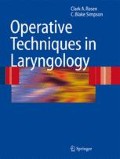Abstract
■ Up to 50% of voice disorder patients may have coexisting LPR.
■ Twice-a-day therapy with a proton pump inhibitor results in the highest symptom resolution.
■ Muscletension patterns I–IV seen in MTD are not pathognomonic for this disorder and can be seen in other voice disorders such as spasmodic dysphonia, and even some normal voices.
■ PVFMD is treated best with multimodality treatment that includes respiratory retraining (voice therapy) and proton pump inhibitors, as LPR is a common trigger for PVFMD episodes.
Access this chapter
Tax calculation will be finalised at checkout
Purchases are for personal use only
Preview
Unable to display preview. Download preview PDF.
Selected Bibliography
Park W, Hicks DM, Khandwala F et al (2005) Laryngopharyngeal reflux: prospective cohort study evaluating optimal dose of proton-pump inhibitor therapy and pretherapy predictors of response. Laryngoscope 115:1230–1238
Belafsky PC, Postma GN, Koufman JA (2001) Laryngopharyngeal reflux symptoms improve before changes in physical findings. Laryngoscope 111:979–981
Vaezi MF (2003) Gastroesophageal reflux disease and the larynx. J Clin Gastroenterol 36:198–203
de Lima Pontes PA, De Biase NG, Gadelha ME (1999) Clinical evolution of laryngeal granulomas: treatment and prognosis. Laryngoscope 109(Pt. 1):289–294
Walner DL, Stern Y, Gerber ME, Rudolph C, Baldwin CY, Cotton RT (1998) Gastroesophageal reflux in patients with subglottic stenosis. Arch Otolaryngol Head Neck Surg 124:551–555
Jaspersen D, Kulig M, Labenz J et al (2003) Prevalence of extra-oesphageal manifestations in gastro-oesophageal reflux disease: an analysis based on the Pro-GERD study. Aliment Pharmacol Ther 17:1515–1520
Mehanna HM, Kuo T, Chaplin J, Taylor G, Morton RP (2004) Fungal laryngitis in immunocompetent patients. J Laryngol Otol 118:379–381
Roland NJ, Bhalla RK, Earis J (2004) The local side effects of inhaled corticosteroids: current understanding and review of the literature. Chest 126:213–219
Sulica L (2005) Laryngeal thrush. Ann Otol Rhinol Laryngol 114:369–375
Mirza N, Schwartz SK, Antin-Ozerkis DA (2004) Laryngeal findings in users of combination corticosteroid and bronchodilator therapy. Laryngoscope 114:1566–1569
DelGaudio JM (2002) Steroid inhaler laryngitis: dysphonia caused by inhaled fluticasone therapy. Arch Otolaryngol Head Neck Surg 128:677–681
Woo P, Mendelsohn J, Humphrey D (1995) Rheumatoid nodules of the larynx. Ear Nose Throat J 113:147–150
Nanke Y, Kotake S, Yonemoto K, Hara M, Hasegawa M, Kamatani N (2001) Cricoarytenoid arthritis with rheumatoid arthritis and systemic lupus erythematosus. J Rheumatol 28:624–626
Devaney K, Ferlito A, Devaney SL, Hunter BC, Rinaldo A (1998) Clinicopathological consultation: Wegener’s granulomatosis of the head and neck. Ann Otol Rhinol Laryngol 107:439–445
Herridge MS, Pearson FG, Downey GP (1996) Subglottic stenosis complicating Wegener’s granulomatosis: surgical repair as a viable treatment option. J Thorac Cardiovasc Surg 111:961–966
Stappaerts I, Van Laer C, Deschepper K, Van de Heyning P, Vermeire P (2000) Endoscopic management of severe subglottic stenosis in Wegener’s granulomatosis. Clin Rheumatol 19:315–317
Bartels H, Dikkers FG, Lokhorst HM, Van der Wal JE, Hazenberg BPC (2004) Laryngeal amyloidosis: localized versus systemic disease and update on diagnosis and therapy. Ann Otol Rhinol Laryngol 113:741–748
Akst LM, Thompson LDR (2003) Larynx amyloidosis. Ear Nose Throat J 82(11):844–845
Sulica L (2004) Contemporary management of spasmodic dysphonia. Curr Opin Otolaryngol Head Neck Surg 12:543–548
Warrick P, Dromey C, Irish JC, Durkin L, Pakiam A, Lang A (2000) Botulinum toxin for essential tremor of the voice with multiple anatomical sites of tremor: a crossover design study of unilateral versus bilateral injection. Laryngoscope 110:1366–1374.
Sullivan KL, Hauser RA, Zesiewicz TA (2003) Essential tremor: epidemiology, diagnosis, and treatment. Neurologist 10:250–258
Zesiewicz TA, Elble R, Louis ED et al (2005) Practice parameter: therapies for essential tremor. Neurology 53:2008–2020
Blumin JH, Picolinksy DE, Atkins JP (2004) Laryngeal findings in advanced Parkinson’s disease. Ann Otol Rhinol Laryngol 113:253–258
Roy N (2003) Functional dysphonia. Curr Opin Otolaryngol Head Neck Surg 11:144–148
Altman KW, Simpson CB, Amina MR, Abaza M, Balkissoon R, Casiano RR (2002) Cough and paradoxical vocal fold motion. Otolaryngol Head Neck Surg 127:501–511
Maschka D, Bauman NM, McCray PB et al (1997) A classification scheme for paradoxical vocal cord motion. Laryngoscope 107:1429–1435
Morrison M, Rammage L, Emami AJ (1999) The irritable larynx syndrome. J Voice 13:447–455
Lee B, Woo P (2005) Chronic cough as a sign of laryngeal sensory neuropathy: diagnosis and treatment. Ann Otol Rhinol Laryngol 114:253–257
Amin MR, Koufman JA (2001) Vagal neuropathy after upper respiratory infection: a viral etiology? Am J Otolaryngol 22:251–256
Chadwick SJ (2003) Allergy and the contemporary laryngologist. Otolaryngol Clin N Am 36:957–988
Watts CR, Early SE (2002) Corticosteroids: effects on voice. Curr Opin Otolaryngol Head Neck Surg 10:168–172
Baker J (1999) A report on alterations to the speaking and singing voices of four women following hormonal therapy with virilizing agents. J Voice 13:496–507
Amir O, Biron-Shental T, Muchnik C, Kishon-Rabin L (2003) Do oral contraceptives improve vocal quality? Limited trail on low-dose formulations. Obstet Gynecol 101:773–777
Columbia University at New York Presbyterian Hospital, College of Physicians and Surgeons, Voice and Swallowing Center (2005) Herbal medications. http://www.voiceandswallowing.com/Voicetreat_herb.htm
Murry T, Rosen CA (2000) Vocal education for the professional voice user and singer. Otolaryngol Clin N Am 33:967–981
Rights and permissions
Copyright information
© 2008 Springer-Verlag Berlin Heidelberg
About this chapter
Cite this chapter
(2008). Nonsurgical Treatment of Voice Disorders. In: Operative Techniques in Laryngology. Springer, Berlin, Heidelberg. https://doi.org/10.1007/978-3-540-68107-6_7
Download citation
DOI: https://doi.org/10.1007/978-3-540-68107-6_7
Publisher Name: Springer, Berlin, Heidelberg
Print ISBN: 978-3-540-25806-3
Online ISBN: 978-3-540-68107-6
eBook Packages: MedicineMedicine (R0)

